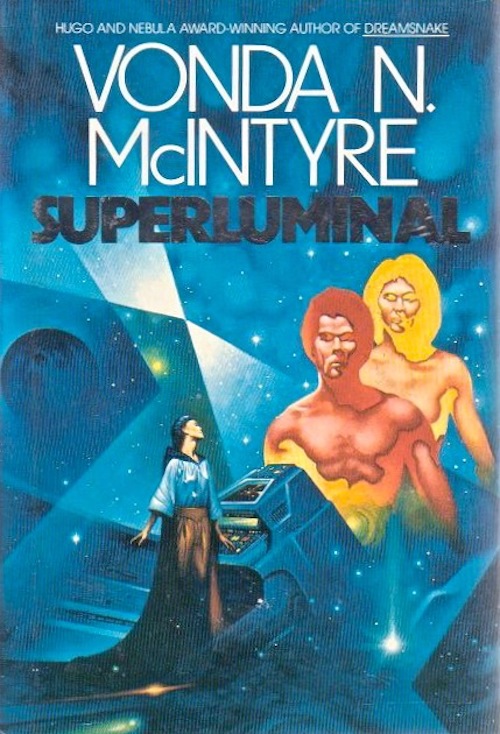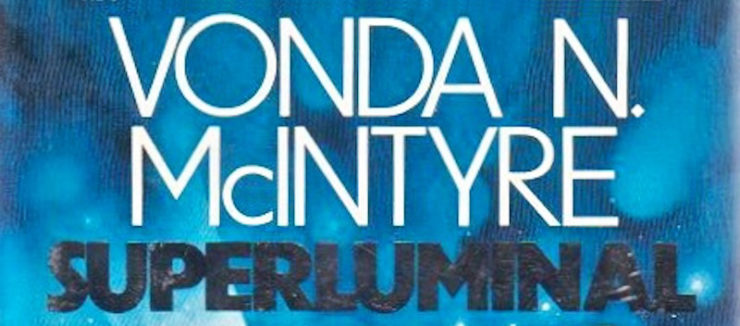I was still grieving the loss of Vonda N. McIntyre when I read the controversial interview by Ian McEwan in The Guardian.
Like many others, my initial reaction to his comments was anger: How dare this person ignore the rich traditions of the genre and claim that his work is without precedent while throwing shade at some of our honoured tropes?
Those old “genre vs. literary” anxieties seem to lurk beneath the surface, ever present, waiting for the next opportunity to throw our technosocial microcosms into a tizzy whenever allegiances are declared. In the piece, published on April 14th, McEwan states:
There could be an opening of a mental space for novelists to explore this future, not in terms of travelling at 10 times the speed of light in anti-gravity boots, but in actually looking at the human dilemmas of being close up to something that you know to be artificial but which thinks like you.
McEwan later clarified his remarks and said he would be honoured for his latest work to be counted as science fiction, citing genre influences such as Blade Runner and Ursula K. Le Guin. But that initial quote has stuck with me, because even his apology made it sound like he is still working to overcome his perception of the borders between science fiction and traditional literary forms such as “the moral dilemma novel.”
In reality, those borders, if there are any left at all, are so fuzzy and permeable as to matter very little.
You want moral dilemmas and faster-than-light travel? Let’s talk about one of my favourite books in my personal pantheon of sci-fi legends: McIntyre’s Superluminal.
Sex! Cyborgs! Mer-people! Inter-dimensional exploration!
McIntyre’s 1983 novel has all the markings of classic science fiction. It’s also a story grounded in intersectionality and boundary disruption, far more deserving of intelligent analysis than its contemporary reviewers appeared to believe (a Kirkus review called it “bland,” and I could not disagree more).
Superluminal is one of the fictional works referenced by Donna Haraway in her iconic and prescient 1985 essay “A Cyborg Manifesto,” which led me to pick up a copy of McIntyre’s work while studying Haraway in my final year of university.
The part that struck me, after Haraway summarized the narrative, was this:
All the characters explore the limits of language; the dream of communicating experience; and the necessity of limitation, partiality, and intimacy even in this world of protean transformation and connection. Superluminal stands also for the defining contradictions of a cyborg world in another sense; it embodies textually the intersection of feminist theory and colonial discourse in the science fiction.
Obviously, I had to read this book.

“She gave up her heart quite willingly.”
The story opens with Laenea recovering from an operation to replace her heart with a mechanical control, subverting her natural biological rhythms to allow her to experience faster-than-light transit. The pilots are also sometimes derogatorily referred to as Aztecs, an allusion to the sacrifice of their hearts, of their humanity, in exchange for the perception required for interdimensional travel. Laenea is a volunteer cyborg, and deeply committed to her choice despite the problems it poses for her romantic entanglements.
Enter Radu Dracul (no relation). A crewmember from the colonized planet Twilight (nope, no connection there, either). His entire family was lost to a terrible plague during his childhood, a plague which nearly cost him his own life before the introduction of a timely vaccine which may have had unforeseen impacts. He has a distinctive sense of time that leads to unprecedented discoveries.
Laenea and Radu engage in a whirlwind romance that culminates in the realization that there are reasons for the distancing between pilots and crew due to their sensitive, disparate chronobiology. Laenea does indeed give her heart up quite willingly, in both cases. Her choice between human connection or experiencing superluminal transit is a rich dilemma, especially as that connection becomes essential to finding her way home.
Orca is the third protagonist, a character who makes me wish I could read an entire series just about her and her extended family—including the whales she refers to as “cousins.” She is a diver, a new species of humans genetically engineered to exist on either land or sea and who can communicate with marine life. She brings a necessary perspective to the narrative as someone who has contemplated the vastness of the ocean and all its unexplored depths, observing the edge of the universe and being drawn to the mysteries there.
The patterns the whales used for communication, the three-dimensional shapes, as transparent to sound as solid objects, could express any concept. Any concept except, perhaps, vacuum, infinity, nothingness so complete it would never become anything. The nearest way she could try to describe it was with silence. (McIntyre, Superluminal)
But as the divers debate whether to undergo a permanent and irreversible transition, Orca finds herself set apart from her people, tasked with returning to the limits of outer space and bringing back the knowledge to share with her underwater community.
Laenea, Radu, and Orca each struggle with very human dilemmas while being distinct from humanity—by choice, by chance, or by design.
“A cyborg is a cybernetic organism, a hybrid of machine and organism, a creature of social reality as well as a creature of fiction,” writes Haraway. The concept of the cyborg asks that we re-evaluate our conception of humans and technology as being distinct and separate.
Characterized by Haraway as a “border war,” the cyborg offers the possibility of radically reconfiguring the tensions between the organic and inorganic. As a metaphor for boundary disruption, authors like McIntyre use the cyborg to complicate our understanding of constructed dichotomies of what is human (and valued), and what is artificial (and exploited).
The cyborg represents something never encountered before. But the cyborg identity proposed by Haraway is not limited to the individual body; it is best encompassed in the relationship of the body to other bodies and other technologies, in a way that complicates the apparent divisions between the self/other. Its radical potential is retained in these relationships as a means to subvert traditional paradigms.
While initially presented in the context of second wave feminist identity in order to address emerging issues of race and intersectionality, Haraway’s cyborg offers a way of reconciling tensions by refusing to (re)colonize them into a homogenized identity muddied by historical preconceptions. McIntyre’s fusion of classic sci-fi with these emergent dialogues is part of an important legacy of boundary transgression in science fiction, from the work of Margaret Cavendish and Mary Shelley to 20th-century icons like Le Guin and Octavia Butler. And the conversation continues as contemporary authors present their own take on the cyborg:
—Kelly Robson does masterful work with her time travelling ecological surveyors in Gods, Monsters and the Lucky Peach. Minh, the protagonist and another “plague baby,” decides that her life and research are enhanced with the aid of her prosthetic tentacles—something normalized by the 2260s, but slightly horrifying to residents of 2024 BCE. The ethics of interference in less technologically advanced societies takes a drastic turn in Robson’s hands.
—In her short story “Egg Island,” Karen Heuler fuses the organic and inorganic with a team of researchers who share a commonality in the use of plastic for their prosthetics. It’s a hopeful tale of evolution and community, of nature triumphing over humanity’s worst excesses.
“Does your arm ever bother you?” Michael asked her.
She looked down at it; it had become familiar, it had become a part of her. “No,” she said. “Not at all. It’s part of me now.”
—In his interview, McEwan also notes his anxiety over automated vehicles and the risks involved in allowing machines to make split-second, life or death decisions. When I first read “STET” by Sarah Gailey, I was turning it over in my mind for days afterwards, re-reading, sharing with friends. The unique structure is itself a disruption of the academic form, and the story is a gut check that should be required reading in any modern ethics class.
There are countless other examples of science fiction in which these tensions between human and machine, the organic and inorganic, are front and centre. Our collective desire and anxiety over technological advancement form the foundation of so many of the most interesting and complex conversations happening in the genre—past, present, and future.
As genre readers, writers, and fans, one of our greatest strengths is our ability to disregard convention in order to imagine something impossible and new. Vonda N. McIntyre was one of those authors who strived to expand those borders, and in doing so she made space for authors like me to grow into the genre.
Superluminal was the first of her books I had ever read, and it provoked many questions and curiosities that I continue to play with in my own writing, adding to the conversations started by her and others like her. And one of the lessons I learned from McIntyre is to always welcome the newbies. So, with that in mind…
Welcome to the conversation, Ian McEwan. I hear you’re a sci-fi fan. I am too.
Rebecca Diem is an author and poet of smart, hopeful speculative fiction. Her work includes the steampunk novella series Tales of the Captain Duke. Rebecca now calls Toronto home and is on a never-ending quest to find the perfect café and writing spot. You can follow her adventures on Instagram or Twitter or visit her website for more stories.










